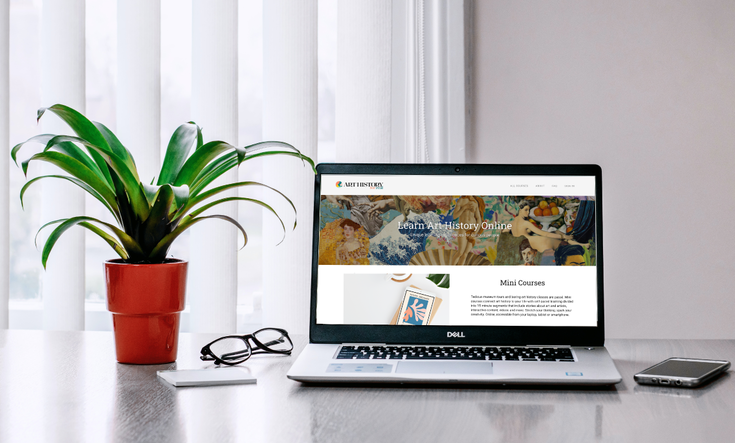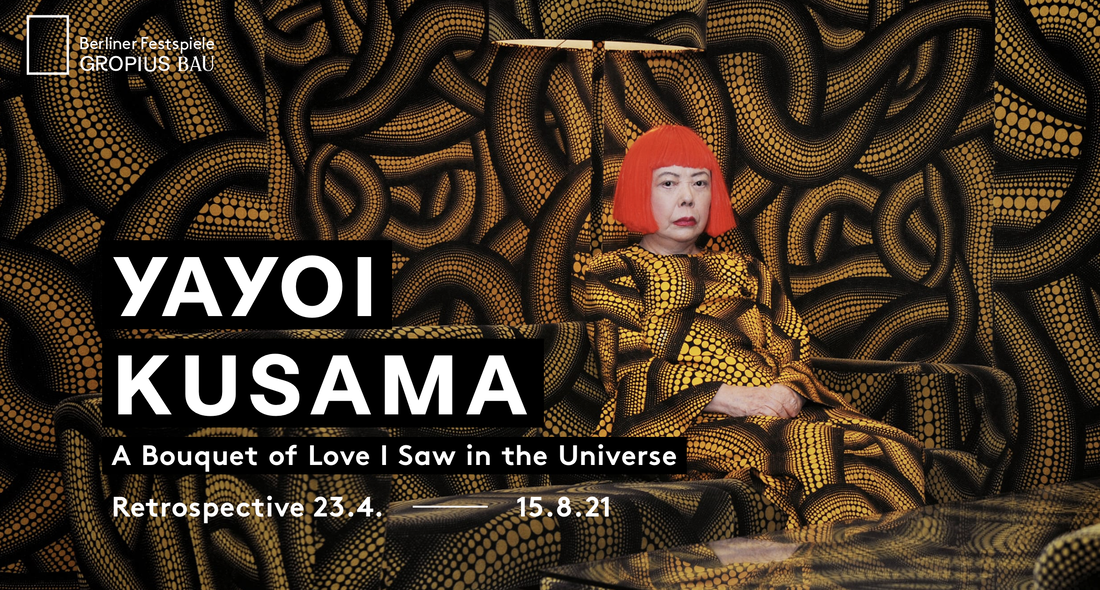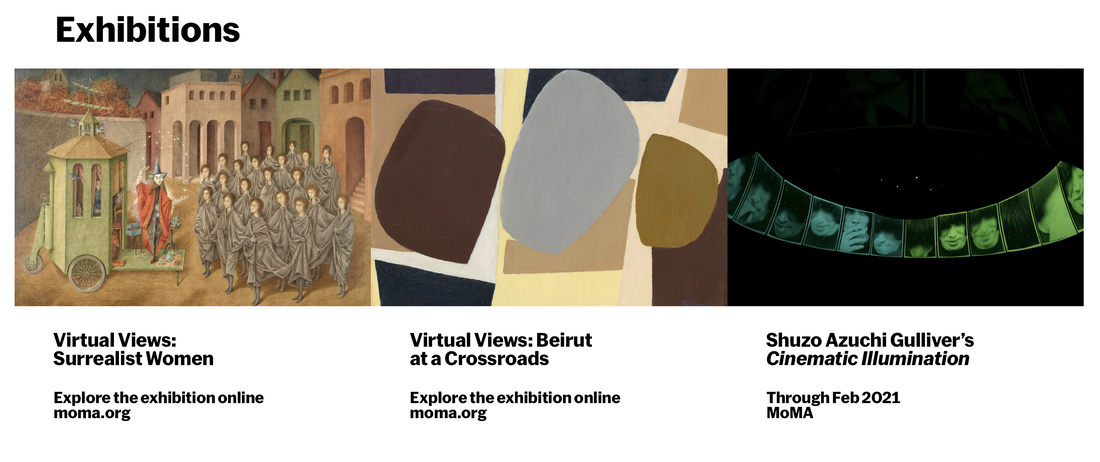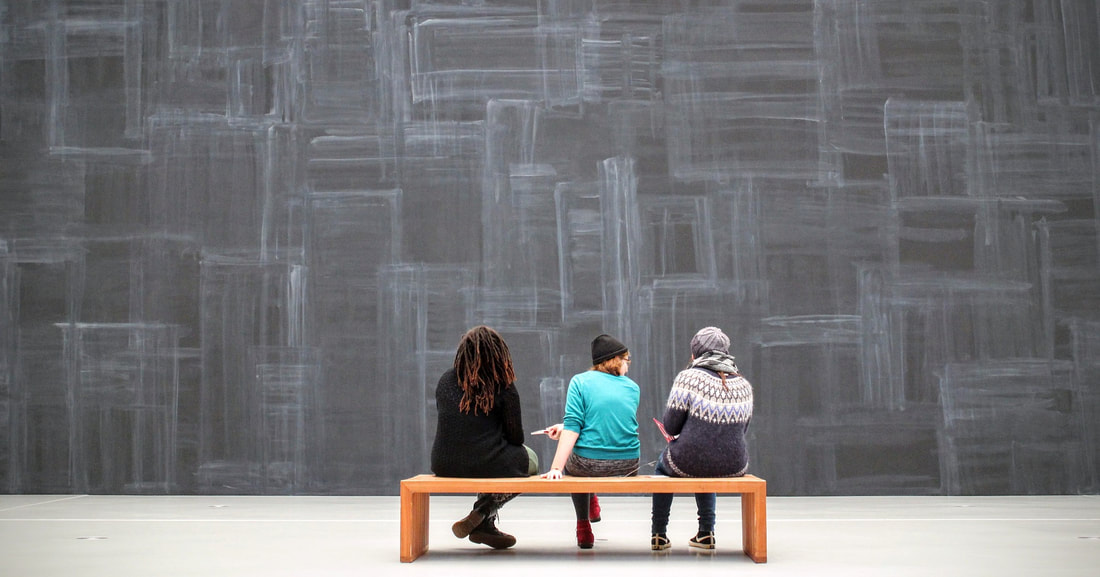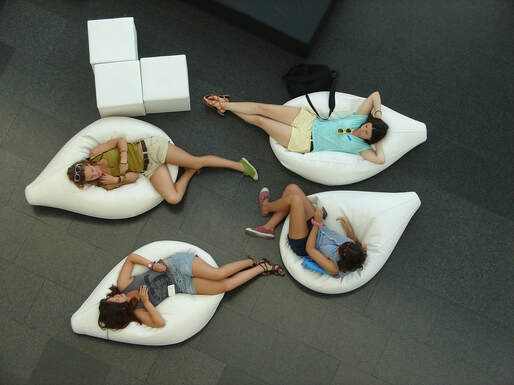|
Visiting a museum in 2021 is almost as challenging as it was in 2020. Last year museums around the world were closed for at a minimum of six months while attendance at the top 100 museums dropped a whopping of 77%! Some museums are beginning to reopen after being closed for a full year, while others had opened yet are closed again as I write this due to third waves of COVID. Fortunately for the art-starved some museums have fast-tracked their online offerings and provide dynamic ways to engage and experience art from home. I share here my favorite interactive digital works, programs and ongoing live events offered on Zoom, Instagram Live and YouTube. Interactive Online ExhibitionsYayoi Kusauma at 92 years old is one of the world’s most famous contemporary artists. This year several exhibitions of her work are featured in museums around the globe. Some offer experiences from home including Gropius Bau's exhibition Yayoi Kusauma: A Bouquet of Love I Saw in The Universe. Gropius Bau’s guide delivers an experience that allows you to explore Kusauma’s works online. It explores Kusauma’s works from her lengthy artistic career and reveals how her art goes well beyond the iconic polka dots. There is depth to Kusauma’s art that address social and cultural themes. Another excellent interactive where you can experience the art and learn about the artist is Alice Neel’s New York exhibition put online by The Met. The exhibition celebrates Alice Neel, a painter of real life in New York City. I love one of her quotes, “One of the reasons I painted was to catch life as it goes by, right hot off the griddle”. My favorites are her works of pregnant women; she paints what male artists typically do not. Galleries of Alice Neel’s works are here. There’s much to explore. Take your time. Live Virtual EventsA handful of museums offer live events online via social platforms and/or on Zoom. One of my favorites is Instagram Live—events are typically live in the museum and led by a curator or guide through a special exhibition. The downside is it is tough to know when these events are scheduled. Another venue is Facebook live events. I suggest following your favorite museum on Facebook to be notified of events offered. Below are a handful of events you can plan for. Newark Museum from Home: The Newark Museum offers a robust roster of online events; most are free. Signing up for their newsletter will give you the scoop on upcoming events. Events include cooking classes based on artworks, art and happy hour, virtual tours and more. I love their tagline: ‘Virtual experiences for all at #NMOAathome. The Frick Collection in New York City offers weekly cocktail with a curator, a mini series exploring a work of art via YouTube Live. They also offer free Zoom sessions titled “Continue the Conversation” that explore a work of art with guided conversation. Canadian McMichael Collection. One of my favorite Canadian museums is the McMichael Collection. They have an excellent collection to explore online, as well as offer free guided virtual tours around specific exhibitions. Currently they are offering A Like Vision: The Group of Seven at 100. It is excellent. More to Explore...There are other alternatives including recorded art talks by Harvard University. They offer a series of brief featuring in-depth views of art objects--Art Talks at the Harvard Museum. Another is Heni Talks, one of my favorite sites for excellent quality videos on various topics in art history.
Cheers and enjoy! PS Check out my platform Art History For Real which offers unique Mini Courses on art history through a modern lens! Museums will be forever changed after 2020. A tsunami named COVID-19 crashed into the museum world and turned it upside down. The director of the Louvre said the Coronavirus has created the worst crisis for its institution in peacetime. Museums worldwide are still experiencing the effects. Over 28% of museum staff have been furloughed, museums worldwide have serious budget shortfalls, and according to the American Alliance of Museums one third of US museums are at risk of permanently closing. As I write this, thirty percent of museums worldwide are closed due to Coronavirus, and those that have opened are seeing drastic reductions in visitors. One worrisome example is the Van Gogh Museum in Amsterdam. Visitor traffic is down significantly. Typical number of visitors per day was in the 6,500 range, now it’s closer to 400 according to the museum director. Some museums, like those in Los Angeles-area where I live have been closed since March and won’t reopen until 2021. Museum attendance is not expected to recover to pre-COVID numbers until at least 2023, if not later. Compounding museums’ woes is the devastating tragedy of George Floyd’s death. It has been a catalyst for museum workers and the public to demand that racial inequities be addressed within museums’ staff and board of directors, as well as within its collections. Change is needed. For way too long museums have been irrelevant and unapproachable to the average person, There is an intellectual elitism associated with museums that they have perpetuated by their policies and practices. But there is a sliver lining. With any seismic upheaval like this one there is opportunity. Museums have been forced to re-evaluate how they serve the public given they are fundamentally, public-serving institutions. Even museums not funded by government dollars are obliged to serve the public given the tax policies and breaks for donors that allow these institutions to operate as non-profits. COVID has created an opportunity for museums to re-think how to engage with the public, how to make their spaces dynamic and relevant both online and in-person. Changes So Far With the initial COVID induced shut downs in March, museums around the world closed. Yet even when schools and other institutions re-opened, museums remain shuttered. Most perplexing were the museums that chose not to re-open even when they had the green light to do so. The message to the general public is clear—museums are in the category of “non-essential”. Museums and the culture they provide appear discretionary. Fortunately many museums were quick to assert their relevancy. They reacted by engaging virtual visitors with Instagram contests and live events, online virtual tours and YouTube videos. Others were later to the party but nevertheless adapted with online offerings. Some still haven’t figured it out—they have failed to offer coherent or adequate programs or resources online. They are stagnate in a fast-changing environment that demands adaptability. But change is happening in some museums, with new approaches to online offerings, collecting practices, exhibition and operational strategies. Below are three areas where change is happening, visible change that will move museums forward. 1. Online Presence It is exciting that many museums now liken the online visitor to the in-person one. Savvy museums have realized that the number of visitors who can visit online to its website, is exponentially larger than those who can visit in-person to its physical location. There is enormous potential to leverage digital technologies to attract and provide an experience for people who could never visit a given museum in-person. But it will be a shift for museums to consider online visitors the same as in-person ones. Typically museums have counted visitor numbers through tickets sales or entry counters. It’s been a metric for success. But similar to other public serving entities affected by the Coronavirus, the model needs to change. Below is a curated list of museums who have responded to the current environment of increased digital consumption, and offer robust and engaging online programs.
2. Rethinking Approaches to Exhibitions, Collecting and Interpretation Museums are re-thinking everything including what they exhibit and collect and how they interpret their collections in light of racial injustices underscored by recent events. The discussion about repatriation of artifacts is also taking on new significance. The pressure is on. Deaccessioning, where museums sell works of art to buy other works of art, is another hot topic. Some museums are selling artworks to fund purchases of works to balance inequities within their collections. But it’s not so easy for smaller museums especially. What happens when a key piece of art, one that is the main draw for the museum, is put up for sale? How does this impact the sustainability of the museum? One case study is Baltimore Museum of Art. It recently put up for sale three of its best-known works of art in order to use funds from the sales to purchase other works, with the goal of achieving equity within its collection. There was a huge uproar in the museum community. The sale was halted just hours before it was scheduled to begin. Two board members resigned over the controversy. This is just one of many ongoing debates within the museum world in 2020. 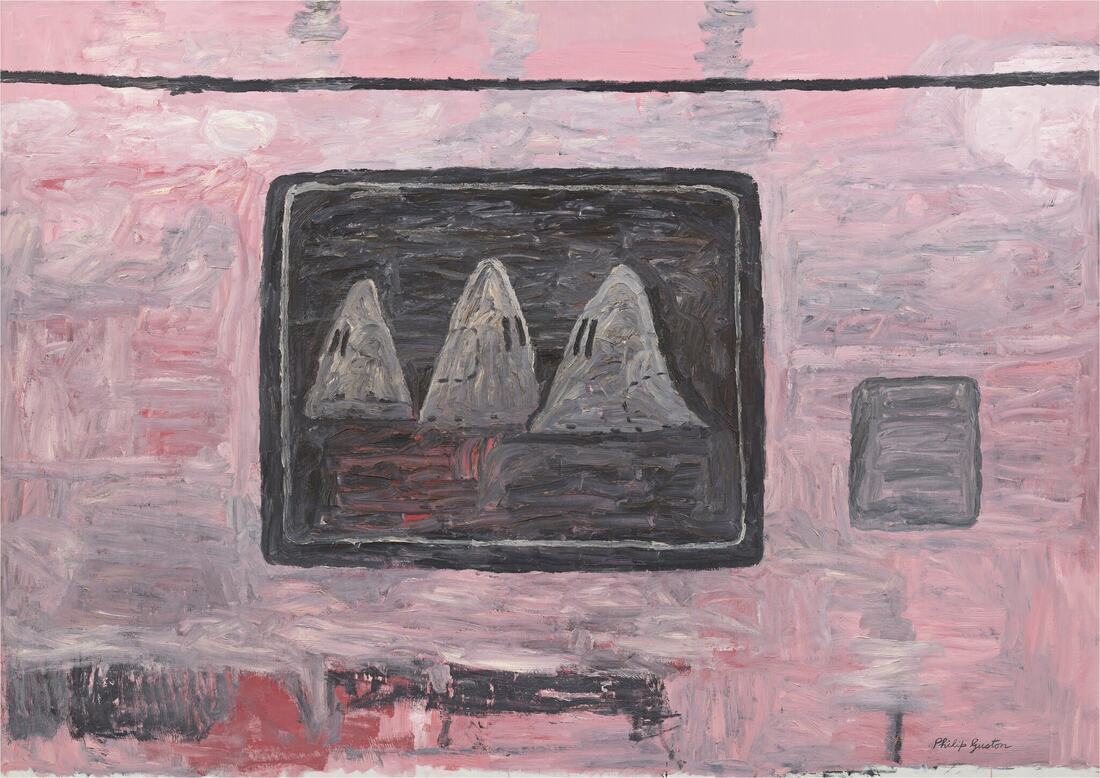 Image of painting by Philip Guston that was to be part of the exhibition that was postponed until 2024 because of concerns about works that show hooded Klansmen. The Klan paintings “require interpretation" according to the four museums who were putting on the exhibition (New York Times, September 25, 2020). Exhibitions in 2020 are also being re-examined, and not without controversy. A recent example is the postponement of a retrospective of Philip Guston’s works, originally scheduled for 2020. It is now postponed until 2024. The much-anticipated exhibition included works of cartoonish-style paintings of the Klu Klux Klan. Guston was the son of persecuted Jewish parents who immigrated to Canada from the Ukraine in 1913. The announcement from the four museums putting on the exhibition stated “postponing the exhibition until a time at which we think that the powerful message of social and racial justice that is at the center of Philip Guston’s work can be more clearly interpreted”. The statement went on to say that the additional voices and and perspectives need to be considered, and this would “take time”. But four years is ludicrous. Critics abound. The postponement is symbolic of all that is wrong with museums: the decades-long history of racial inequalities, the condescending nature of museums towards visitors, (that the public can’t contextualize and analyze artworks on their own), not to mention the glacial pace of change (case in point with this exhibition - four years to re-interpret the works). On the positive side, issues are being discussed and voices heard. 3. Addressing change: @ChangetheMuseum and @abettergugenheim There has also been pressure for change within museums’ ranks. Social media has played a role by allowing anonymous individuals to post experiences of racial profiling, undermining and discrimination experienced while working within museums. An Instagram account, @ChangetheMuseum is one platform, with over forty thousand followers. Some stories are shocking, museums are called out, often with names of museums and occasionally specific employees. The account has received criticism given their anonymous posters, and their call to boycott museums in October with their campaign #NoMuseumOctober. But the stories need to be heard. One hundred and sixty nine employees from the Guggenheim Museum in New York banded together calling themselves, ‘A Better Guggenheim’ and sent a letter to its board with allegations of sexism, racism and a toxic work place. The group's Instagram account, @abetterguggenheim, calls out the injustices at the museum publicly and demands that key people in leadership roles at the museum resign. The campaign is ongoing, and last month one of those named to resign did so. The New Museum Experience: 2021 and Beyond The museum in-person experience with COVID restrictions creates barriers for visitors, with limits on visitor numbers, the need for online bookings, and the constrained movement within the museum due to social distancing requirements, all which affect people’s willingness to visit. We already are seeing the effects as mentioned. As I've discussed, now is a great time for the museum experience to change, for museums to adapt to the needs of visitors, to shift their focus to involve and engage visitors. Below is a list of outcomes that museums could strive for, that leverage the challenges of 2020, in order to reset and re-create the visitor experience with new approaches and strategies.
Despite the challenges facing the museum world I am optimistic, but cautiously so. Some museums will be able to adapt, and are already doing so by taking bold steps to create dynamic experiences. MoMA in New York is a good example, as is the McMichael Canadian Art Collection. I look forward to visiting museums that prevail beyond 2021—online and in-person; those that can create a museum experience that is visitor-focused, dynamic, engaging, relevant and real. I can hardly wait. The idea of what a museum IS, is changing. Recent openings (and popularity) of museums such as Museum of Ice Cream in New York City and San Francisco, and the Egg House, an egg-themed pop-up museum in New York City among others push the boundaries of our concept of what a ‘museum’ is. But what’s challenging the status quo even more than ice cream museums are controversies facing museums like donation sources and board members corporate affiliations. Most recently we have the Sackler Family controversy; the family who have donated millions to museums worldwide, yet the funding is now viewed as tainted given the family’s wealth stems from Purdue Pharma, the company charged with exacerbating the opioid crisis. Museums have been scrambling—strategizing how to respond. Though protests over museum funding sources is not new, it’s front and center now with social media and public sharing platforms. The changing face of museums and the public’s responses to high profile issues has put forth challenging questions for the museum community—what is a museum? What place do they have in our culture? What are the roles and rights of visitors? A Proposed ‘New’ Definition for Museums These weighty issues no doubt contributed to the International Council of Museums (ICOMs) decision to create a new definition for its members this year. The ICOM is a global membership association that represents 40,000 members from 141 countries. Its overall aim is to establish professional and ethical standards for museums; its website states that it’s the “voice of museum professionals an international stage”. Yet there was lots of drama when the ICOM put forth its new definition that differs drastically from its existing one which was modified in 2007. More so since the ICOM (initially) didn’t solicit feedback from members. And though a new definition is needed—agreed by the majority of ICOM members, the new one is deemed “too political”, “too idealogical”, reaching beyond the scope of museums’ purpose (Noce, 2019). It reads: “Museums are democratising, inclusive and polyphonic spaces for critical dialogue about the pasts and the futures. Acknowledging and addressing the conflicts and challenges of the present, they hold artefacts and specimens in trust for society, safeguard diverse memories for future generations and guarantee equal rights and equal access to heritage for all people. Museums are not for profit. They are participatory and transparent, and work in active partnership with and for diverse communities to collect, preserve, research, interpret, exhibit, and enhance understandings of the world, aiming to contribute to human dignity and social justice, global equality and planetary wellbeing.” It’s long, full of grandiose language. It’s also too rigid, it doesn’t give enough flexibility for small museums to work with. 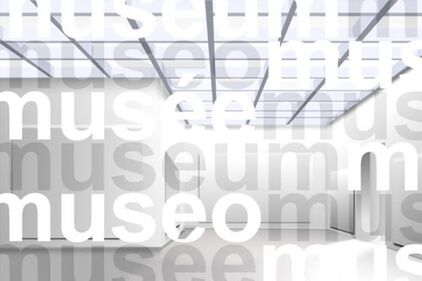 The Visitor is Left in the Dust But seriously folks, the ICOM’s existing definition needs to change—it’s outdated, it’s inwardly focused, it’s institution-centric. The visitor is left in the dust. It barely acknowledges the public. It’s all about them (the museums). This is not going to fly in today’s experience culture, where people want be part of of something. ICOM’s Existing Definition: “A museum is a non-profit, permanent institution in the service of society and its development, open to the public, which acquires, conserves, researches, communicates and exhibits the tangible and intangible heritage of humanity and its environment for the purposes of education, study and enjoyment.” See what I mean? Note the emphasis on the actions of the museum—acquires, conserves, researches, communicates and exhibits. Where is the visitor in all of this? How is the visitor involved, or invited to participate and/or contribute? Granted it says ‘service to society’ but what does that mean? The visiting public is viewed as passive. Even the new definition is not much better in acknowledging, let alone involving visitors.This needs to change, big time. Another Perspective There’s a similar museum membership organization based in the United States, the American Alliance of Museums (AAM). It aims to champion museums and nurture excellence in partnership with our members and allies with a network of members and resources. I was curious how AAM defined museums. But I couldn’t find one on their site other than the section ‘core standards for museums’. I reached out to AAM asking what its stance was on a museum definition. Their emailed response was a prepared statement as follows: “The International Council of Museums' (ICOM) proposed new definition of a museum includes many of the American Alliance of Museums' (AAM) long-held values, including commitments to serving diverse audiences and functioning as inclusive spaces. Definitions can create common understanding and clarity, and this proposed definition is undoubtedly inspiring in many ways. However, definitions can also be used to divide and exclude which is why AAM does not strictly define a museum. Our society and communities are constantly changing, and with that museums need to be nimble and agile to best serve their communities. Setting limitations on the core identity of what a museum can and can't be interferes with that flexibility. We are proud and grateful to have a membership base and global Alliance that is incredibly diverse and know that their diversity makes it impossible to create a single definition that covers all of their needs and identities” It’s certainly a safe statement. They might be lucky and pick up some disgruntled ICOM members. But it really mirrors the AAM’s decision not to have a definition in the first place. It’s risk averse. Perhaps it’s the best way to move forward; let each individual museum decide. Closing Thoughts Not surprising ICOM’s proposed definition was not approved with 70% of members voting against it at the September 2019 conference. Back to the drawing board. But I suggest there needs to be change that goes beyond a new definition for ICOM; what’s really needed is a new mindset and approach within the museum community—a different view on their collections, purpose and visitors. I like how museum scholar Stephen Weil described it in a paper in 1999, ‘it’s time to shift away from being about something towards being about somebody’. Twenty years later—it’s time. Notes
|
Museums for Real is a blog with insights and ideas on how to make museums relevant and enjoyable for everyone.
|
